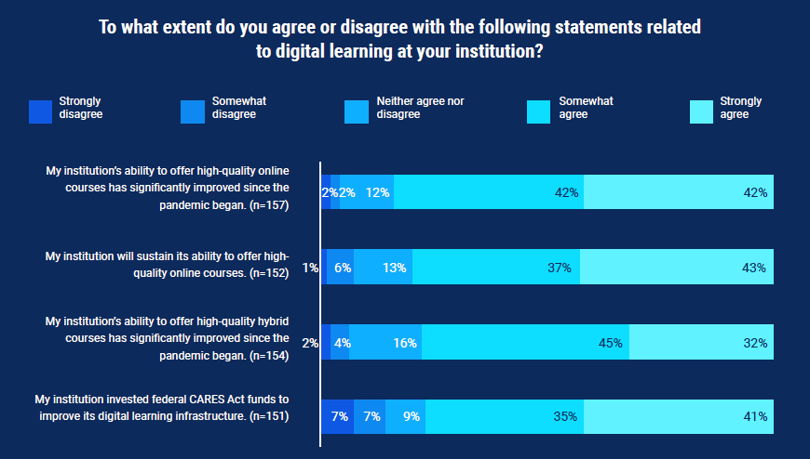What are Higher Ed's Technology Needs in 2023? 175 CIOs Weigh In
By: Ready Education on Jan 17, 2023 10:00:00 AMWhat are Higher Ed's Technology Needs in 2023? 175 CIOs Weigh In
By: Ready Education on Jan 17, 2023 10:00:00 AM
The global pandemic forced all of us to find new ways to connect and collaborate online, but it especially highlighted technology needs across Higher Education. As COVID-19 swept the world, institutions had to figure out how to support online learning requirements as well as increased demands for mobile access to university resources as quickly as possible. Higher Ed tech leaders were hard pressed to find engaging ways for students and faculty to connect with each other and build community virtually too.
Now, more than two years later, new McKinsey research shows “students and faculty are eager to continue using new classroom learning technologies adopted during the pandemic.” The only issue is that McKinsey's research also found “institutions could do more to support the shift.”
The takeaway? While Higher Ed has grown exponentially in recent years when it comes to adopting and implementing technology, there’s still a long way to go.
How are technology leaders across Higher Ed thinking about students’ needs in 2023? And how are they making decisions around investing in different tech tools to deliver a high-quality experience?
Those questions––and more––are exactly what Inside Higher Education’s 2022 Chief Technology/Information Officers Survey set out to answer. Conducted with Hanover Research and published in October 2022, the survey collected responses from 175 technology officers at public, private non-profit, and for-profit colleges across the United States and compiled the findings into a 63-page comprehensive analysis.
As an organization committed to supporting universities with the best technology solutions, we were of course interested in the results. Below are 4 key findings from the survey as well as some ways we’re using them to inform how we’re thinking about future features and offerings.
Read them below and download the full survey here.
#1 Institutions need to prioritize data to be able to make the right decisions and positively impact student success
Making the right decisions to support student success starts with having the right data to better understand students’ needs and develop tools that suit them.
Technology leaders agree with this. Indeed, three-quarters of CIOs say that their school uses data to support student success and 54% try to use it to improve internal processes. However, they still find it challenging to get the right behavioral data. Institutions need to know about students’ learning habits, reasons why they drop out, and challenges they face everyday on campus. And this is the kind of data they are going to be prioritizing moving forward.
We were thrilled to see these findings at Ready Education because this is exactly the kind of data our solutions help institutions collect. Backed by hundreds of hours of research and experienced teams across higher education, our technology platforms help:
- Gather lots of data on how students engage with the institution and how the institution engages with students
- Improve data accuracy
- Use informative data to address individuals’ needs and improve student outcomes, making data analytics more effective
#2 Most institutions know digital transformation is key, but still need to make progress in this direction
All tech leaders know how extremely important digital transformation is for higher education institutions. Here are some key findings from the survey that support this. The majority of CIOs agree that having a mobile app or service would make students’ everyday life on campus easier. At least two-thirds of respondents report that applying to the institution, buying a textbook, and paying a tuition bill are “somewhat” or “extremely” easy to do via a mobile device. And 53% indicate that changing an academic course is easy to do via a mobile device.
Technology investments can have a great impact on institutions and students. First, they help prevent staff burnout. By connecting all the students together, faculty members are not the only facilitators anymore and answering students’ questions and requests becomes easier. Mobile technology also reduces operating costs and provides more support to students, improving their overall experience. Last but not least, mobile solutions create crucial relationships and connections between students that help their long-term success.
But despite understanding how important this is, institutions are still lagging behind where they need to be. Institutions face many challenges when it comes to digital transformation. The main ones that the survey highlights are insufficient financial investment and resistance among staff and faculty members.That’s why two-thirds of CIOs indicate their institution has not set specific goals for digital transformation.
#3 Supporting digital learning is a priority for institutions and CTOs/CIOs
The survey results also highlighted that finding ways to continue supporting digital learning is a priority for higher education technology teams. From a pedagogical perspective, this makes sense since investing in technology helps improve the quality of blended and digital learning resources. It’s an important element for institutions that are looking to attract and support more diverse groups of students (like adult learners and first-generation students).
Most survey respondents agreed that their school provides technical support for teaching and creating online courses, and invests in technology and instructional design resources to improve teaching and learning. The majority of CIOs are satisfied with the quality of the digital learning opportunities at their institution and believe the quality of hybrid and online courses has significantly improved.
But that doesn’t mean there isn’t room for growth or that further investments don’t need to be made. These figures below further demonstrate that institutions have understood how technology and digital tools help increase online and hybrid learning opportunities and improve their quality, meaning we are likely to see institutions continue to explore and evaluate technology investments in 2023.

Source: 2022 Survey of Campus Chief Technology / Information Officers by Inside Highered
Another important fact to take into account is that CIOs spend significantly more time on academic technology-related matters now than they did before the pandemic. About a third spend at least 50% of their time today on academic technology matters, compared to 16% before the pandemic. The global pandemic forced institutions to come up with new technology solutions to support remote learning and teaching requirements, and respond to greater demands for digital communication and mobile access. These technology needs have kept on increasing, hence the necessity to keep investing in this area in 2023.
#4 Most institutions face Tech hiring and retaining challenges
The last key finding we wanted to share with you is that institutions are struggling to hire new technology employees and retain current ones (62%). The main reasons seem to be that technology employees are able to find better salaries (99%) and more flexible remote work policies (53%) at other organizations outside of higher education.
Regarding flexible / remote work, 8 in 10 survey respondents strongly agree that their institution has technology that makes this working style viable. Half say that their institution has policies that encourage remote / flexible work. But 70% strongly agree that employees expect more flexibility to work when and where they want now than before the pandemic.
***
How can we address these challenges? How can we make higher education more attractive for tech employees so institutions have strong technology teams to support staff and students’ needs? READY Education is hosting a webinar on January 25 to answer these questions. In this live roundtable discussion, our panel of experts will dive in to uncover what the survey’s results really tell us and what they mean for student success this year.


.png)
.png)
.png)

